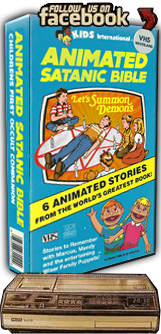 |
|
HELLO AND WELCOME TO VHS WASTELAND, YOUR HOME FOR HIGH RESOLUTION SCANS OF RARE, STRANGE, AND FORGOTTEN VHS COVERS. EACH OF THESE BIZARRE GEMS IS SCANNED AT 200 DPI. SIMPLY CLICK ON THE THUMBNAIL OF ANY VHS COVER TO DOWNLOAD THE FULL HIGH RES FORMAT. WE WILL BE ADDING A NEW COVER DAILY, SO BOOKMARK THIS SITE AND CHECK BACK OFTEN. WE'D ALSO LOVE SUBMISSIONS FROM YOU. IF YOU HAVE A VHS THAT IS WEIRD OR RARE, JUST EMAIL US AT MADHATTERDESIGN@GMAIL.COM. REMEMBER TO SCAN THE FRONT, BACK AND SIDES OF THE VHS AT 300 DPI. WE WON'T ACCEPT LOW RESOLUTION FILES. WHILE YOU'RE HERE, GRABBING OUR AWESOME FREE VHS COVERS, FEEL FREE TO CLICK THE "DONATE" BUTTON ON THE LEFT. IF ENOUGH PEOPLE SEND US SOME CASH, WE MIGHT BE TEMPTED TO KEEP BRINGING YOU THE COOLEST, HIGH RES VHS COVERS ON THE NET. BUT IF YOU GREEDY, COVER GRABBING... I MEAN... YOU WONDERFUL VISITORS TO OUR SITE, DON'T COUGH UP A DONATION, MAYBE WE'LL JUST FIND SOMETHING BETTER TO DO WITH OUR TIME. LIKE GO MAKE NACHOS. MMMMM... NACHOS. SO HELP A BROTHA OUT AND DONATE A LITTLE DOUGH TO THE CAUSE.
LASTLY, WHY NOT VISIT OUR PARENT SITE (SERIALKILLERCALENDAR.COM). IT HAS NOTHING TO DO WITH VHS COVERS BUT I THINK YOU MIGHT BE PLEASANTLY SURPRISED BY WHAT YOU FIND. OR NOT. I DON'T KNOW YOU. MAYBE YOUR NOT SURPRISED BY ANYTHING. MAYBE YOUR THE KIND OF GUY THAT SEES A COW FALL OUT OF THE SKY AND EXPLODE LIKE A PIÑATA AND YOUR ALL LIKE "HUH, THAT WAS WEIRD." MAN. WHAT'S WRONG WITH YOU ANYWAY? JEEZ. SOME PEOPLE.
BUT NO. SERIOUSLY. GO BUY SOME CRAZY AWESOME TRUE CRIME MERCHANDISE AT SERIALKILLERCALENDAR.COM. INCLUDING THE SERIAL KILLER MAGAZINE, THE SERIAL KILLER TRADING CARDS AND MUCH MUCH MORE! DO IT. DO IT NOW. CLICK THE LINK. |

MY FIRST VCR
Published at blog.cyborg5.com
When Sony first introduced the Betamax video recorder I immediately began reading up everything I could about them and later about the competing VHS format introduced by JVC. It was very interesting to watch the battle between these two incompatible tape formats. Although VHS was of inferior quality, it became more widely accepted. Eventually VHS pushed Betamax out of the marketplace thanks to restrictive licensing policies by Sony and the porn industry’s acceptance of VHS. Check out this article about the rise and fall of Beta. The current a battle between incompatible competing Sony BluRay DVD and HD DVD formats is reminiscent of the old Betamax versus VHS battle.
I kept hoping that prices would come down so that I could someday afford one of these dream machines of either format. I remember talking to a salesman about a $450 Betamax and he assured me that never in my lifetime would I see a VCR cheaper than $400. “They are just too complicated a machine to be made any cheaper than that” he insisted. I had spent too much time working with computers and their ever falling prices and ever-increasing capabilities to know that that was a ridiculous assumption. As I said earlier, VCRs bottomed out at about $50-$60 before their untimely demise.
Thanks to a rather generous disability insurance policy from when I worked at IU Genetics Research, I managed to find myself with an unusual amount of disposable income and ended up paying about $1300 for my first VCR. It was an RCA SelectaVision convertible VCR model VFP-170. I’m not sure when I purchased it but here’s a press release dated February 1981. The image on the right is an advertisement for this model. It was called convertible because it was designed to be used as both a tabletop and a portable VCR to be used with a separate video camera. My friend Stu Byram (the one who recorded me singing ” I’m a little Teapot” as a toddler) also had been that same model VCR and had a camera to go with it On a couple of occasions he loaned me his camera to use with my portable recorder.
Amazingly this machine was so primitive that the remote-control was hardwired. That’s right… to work the remote-control you had to drape a 10 foot wire from your TV set to your easy chair. Below are some images of another almost identical model VGP 170 NR which did finally come with a wireless remote. This recently listed on eBay with a minimum bid of $19.95 and it include a camera but it had no bids! As I said earlier I paid $1300 for it.
In this image the piece on the right is the tuner which remained connected to your television and your antenna (this was pre-cable days). The piece on the left was the “portable” recorder which connected to the tuner by a thick cable in the back.
Note that the tuner section had a series of about a dozen buttons which were used to select the channel to record. If you opened a little access hatch on top they were a series of a dozen tiny little thumb wheels that you used to manually tune in your stations. There was a little tiny toggle switch to select VHF channels 2-13 or UHF channels 14-82. The concept of a “cable ready” device was still years off. You could program the device to record anything up to 14 days in advance and not only would it record in standard SP two-hour mode it would also record in four-hour LP mode but it also would use the new six-hour SLP recording mode!
A few years later my uncle Keith bought the RCA model VJP900 which is shown here.
Rather than connect the two pieces using a cable, this one had a sort of docking station that you used to connect the portable section. The model shown here sold on eBay recently for $1.75. Ironically Keith never did buy a camera to go with his “convertible” VCR.
Eventually I did buy an RCA camera of my own to go with it. Note in these days they didn’t call them camcorders because they were not camera and recorder all in one. Dad created a camera mount that allowed me to connect the camera to my wheelchair armrest. We would hang the recorder section on the back of my wheelchair in a bag and even supplanted the battery power of the recorder by plugging a cable into my wheelchair battery. We had to wire in three little buttons on the end of a cable so that I can use the pause/record, zoom in, and zoom out functions. I will have more on these famous the buttons in a later installment here.
I really liked my uncle’s VCR because it had stereo sound capability and you could audio dub to put in narration, music or sound effects. I borrowed his VCR one time so that I could do tape to tape editing of some video I shot in the garage area at the Indianapolis Motor Speedway. I put music in one stereo channel and did narration in the other channel.
I recently dug out that old edited videotape that I had shot at the Speedway which included in narration. Much to my surprise the narration was no longer there. That old stereo VCR used linear recording tracks instead of the flying heads that modern hi-fi stereo VCR’s used today. apparently current VCRs can’t handle that kind of stereo any more.
I don’t remember why or when I got rid of that VCR. At some point I replaced the camera with a new 8mm camcorder. I seem to recall my next big VCR was a very fancy model for which I paid about $900. Its claim to fame was something called “digital effects”. It had some sort of digital frame buffer that when you hit the pause button it would digitally capture the frame and display it perfectly clear from the buffer. It also had some other digital effects built in similar to the kinds of special effects you find built into today’s camcorders. I thought I would use these effects in editing videos but it turned out I never really did any more of that kind of thing.
Well that’s enough nostalgia for now… in the next installment we will talk about about my quest to replace my Toshiba VCR with a VCR/DVD combo even though I didn’t need the DVD section in my bedroom. I will discover it’s not as easy as I expected it to be.
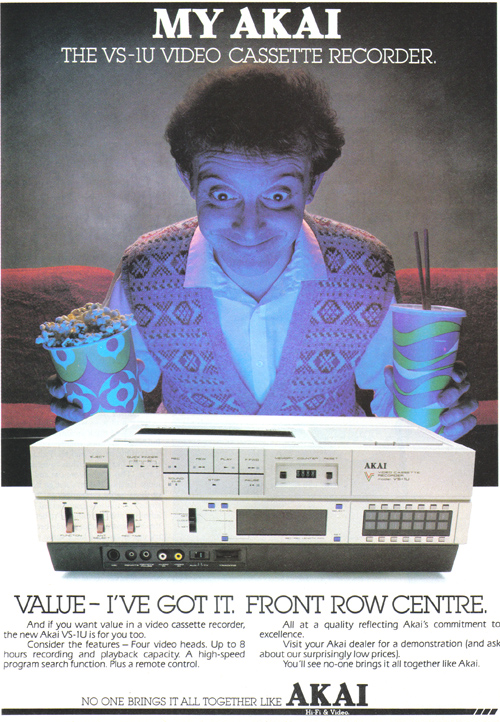
My Passion for Recording
Published at blog.cyborg5.com
This is the second in a series of articles about my recent quest to replace a broken VCR in this era of DVDs, DVRs, and other newfangled gadgets. Click here for the beginning of the series.
I’ve always been fascinated by tape recording ever since I was about four years old and our family friend Stu Byram recorded me singing “I’m a Little Teapot” on an old reel-to-reel tape recorder. When I was about 8 or 9 years old I got a small 3-1/2″ reel-to-reel machine for my birthday. Being the pioneer that I am… I remember taking the tape recorder to the drive-in movie with me to record music from movies like “Mary Poppins” and “AHard Day’s Night“. I swear I’ve never taken a camcorder into a movie theater but I sure was ahead of my time when it came to bootleg soundtracks. It’s a shame that drive-in movies are so rare these days. It sure would be easy to sneak in your camcorder into a drive-in. However the sound quality sure would leave a lot to be desired.
When I was about 12 or 13 years old I moved up to a regular audio cassette player/recorder with a built-in AM/FM radio and my bootlegging ways continued. I would sit there listening to the FM radio waiting for my favorite songs to come on and I would flip it to record as the song started. In fact I would sit there for hours sometimes hitting record just as the DJ would stop talking in hopes that I could catch more of the beginning of the song. If it was a song I didn’t want or already had, I would simply stop the tape, backup little bit, and cue it up for the next song. I was very popular among the kids in the neighborhood because I had a great collection of the latest music and it didn’t cost me a dime.
Another favorite pastime I had was making comedy recordings in the form of a man-on-the-street interview where all the answers to my questions were a line out of a song. I had figured out how to wire into my record player so that I could directly connect it to my tape recorder even though the record player didn’t have a “line out” jack. I would use a microphone to ask a question like “What is your name Miss?” And then I would record a brief few seconds from the Beatles song “Elinor Rigby” from a 45 rpm record. I would then ask “How are you today?” And I would play few seconds of James Brown screaming “I feel good!” And the comedy would deteriorate from there.
I always figured if I was a little bit smarter I could figure out how to connect a television to a cassette recorder but of course if that was possible, somebody would have done it. Audio cassette recorders barely have enough capability to record decent audio let alone the amount of bandwidth you needed to do video.
It turns out that in 1987 Fisher Price did make a toy black-and-white camcorder that used a standard audio cassette for recording. It was called the PXL-2000 PixelVision KiddieCorder. I never owned one because by that time I already had a real camcorder. But I always thought it was great they figured out how to do it. One recently sold on eBay for about $50. Also check out this article from Wikipedia.
Later in high school my fascination with video recording led me to hangout briefly with the high school Audiovisual Club at Northwest High School even though it was the nerdiest group of people in the school. They had a black-and-white camera and video tape recorder that they used to tape basketball and football games for the coaches. Unfortunately all of the tape to place high in the bleachers or a press box so I couldn’t help out with that and I really didn’t have much time to participate in extracurricular activities because the bus would pick me up about 15 or 20 minutes after my last class.
It wasn’t until the early 1980s that my dream of video recording in the home would come through when I purchased my first VCR. Read all about that in our next installment.
Epilog Images from 1984
Published at blog.cyborg5.com
This is the 16th and last in a series of articles about my recent quest to replace a broken VCR in this era of DVDs, DVRs, and other newfangled gadgets. Click here for the beginning of the series.
During the course of writing this series of articles about TVs, VCRs etc. my Dad stumbled across some photographs he took in 1984 of our living room and my bedroom. He kept the photos in a box in the garage for insurance purposes to document our consumer electronics in case they were damaged or stolen. The images of my old kit built computer and of me sitting at my old Radio Shack Model I computer in an earlier installment or from some of those photos. Here are a collection of some other photos with close-ups. You can click on most of the images for larger versions.
The first image shows our old 25 inch color Zenith cable ready TV in our living room. Note that NASCAR is on the screen. On the lower right is a cabinet that contained all of our videotapes. None of them were prerecorded tapes. Most of it was movies and specials we taped off of HBO and other cable channels.
This next image shows the old RCA VFP-170 SelectaVision convertible VCR that is described in an earlier post along with my old video camera. The images I used in a previous post in this blog were all taken from advertisements on eBay or other images I found on the internet. This is the only image I could find of our actual unit.
The image below is a close-up of some boxes sitting on top of the end table cabinet next to the TV. The white box on top that is barely visible is one of those slider style cable boxes I talked about in an earlier installment. It was used for the VCR which was not cable ready. Note that the TV was cable ready and did not require a converter. The brown box below that is an RF distribution box that allowed us to view cable or VCR in the living room, and two bedrooms. I still have a similar box in the living room today that connects the living room devices to my office and my parents’ bedroom.
The next image is a view of my bed with the TV on the wall above it. Note the MC Escher print and the space shuttle poster hanging above the bed. They were there for many years. On the right is my Hoyer that I use to get in and out of bed. Behind that is an old color TV and on top of it is a remote-controlled cable box that I used because the TV wasn’t cable ready.
Finally here is a close-up of the TV with cable box on top of it.
Well that wraps it up for my nostalgic look back at old TVs, VCRs, and cable boxes.
I’m not really sure what my next blog series will be but the next entry in my blog will be my preview of the new fall TV series.
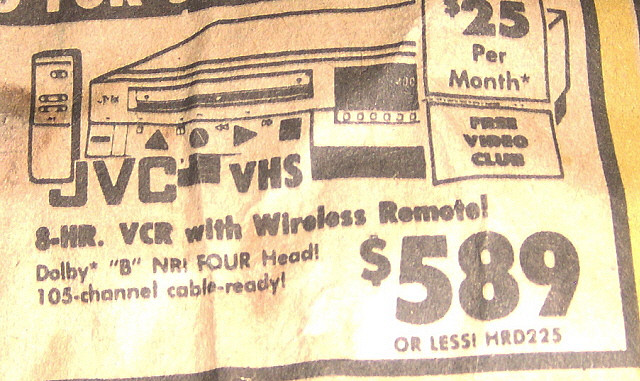
|
|
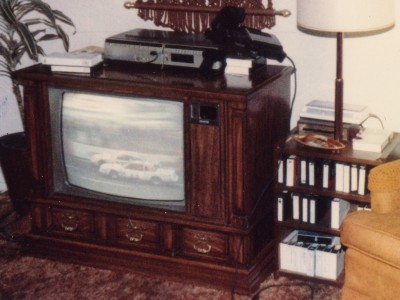
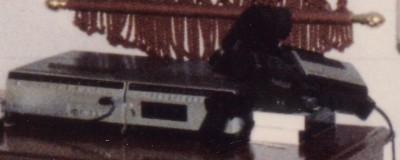
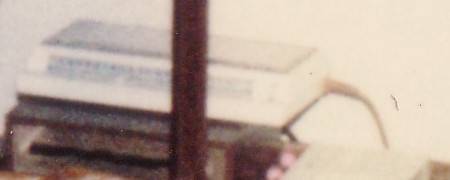

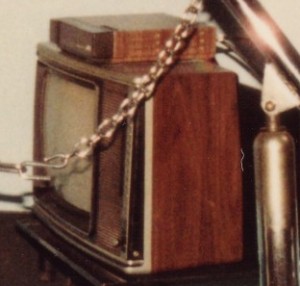
|
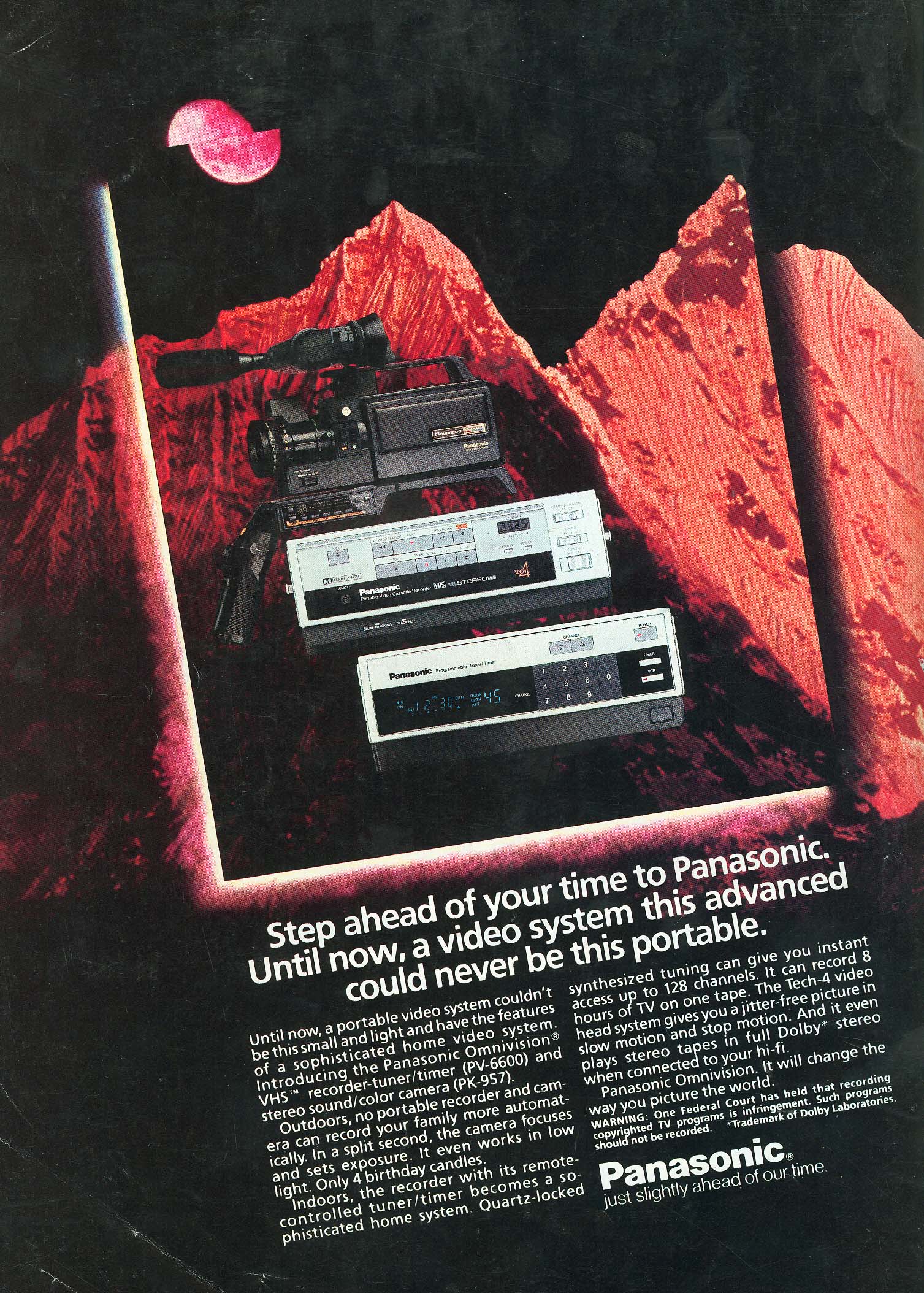
|